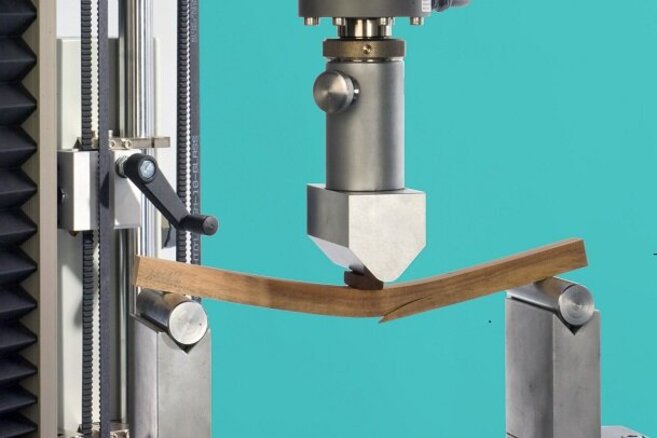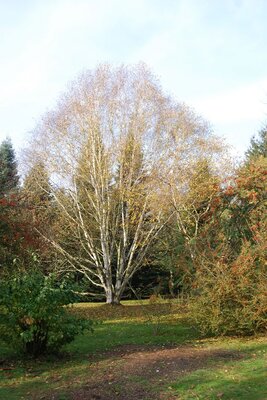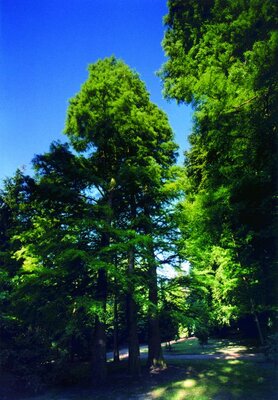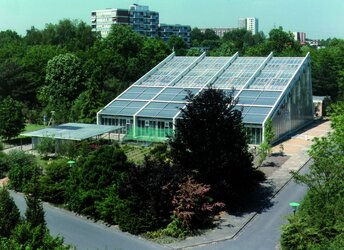Arboretum and Greenhouse
Only in a few places in Germany is it possible to visit an arboretum. This is hardly surprising, because the construction and maintenance require a lot of time in addition to specialist knowledge, floor space and financial resources.
The arboretum and the greenhouse facility of the Thünen Institute provide important forest and timber tree species from all continents and climatic zones for teaching and research. In addition to its primary responsibilities for the Federal Ministry of Food and Agriculture (BMEL), the Thünen Institute also teaches for the study of the timber industry at UHH. The close connection between the Thünen Institutes and the departments of the UHH enables Bachelor’s and Master’s graduates and doctoral students to obtain a practical qualification and in return offers the Thünen Institute research results from the higher education sector.
The total tree population of the arboretum and greenhouse complex currently (as of 2013) comprises about 1,570 species and varieties belonging to about 126 families from all over the world.
The arboretum
This arboretum was built in 1964. Some very much older trees originate from the former estate era of this area and have been integrated.
The arboretum, with an area of about 10 hectares, is divided into geographical regions and includes a dendrological (articultural) educational trail in the southeastern part of the area.
Swamp cypresses (Taxodium distichum) at the age of about 70 years, native to the southeastern USA, are among the many attractions with their extremely durable heartwood as well as a group of “living fossils”, the original redwood (Metasequoia glyptostroboides). This summer-green conifer was considered extinct until its rediscovery in 1941 in an inaccessible mountainous region of China, and until then only fossils existed. The bristle pine (Pinus longaeva) are also remarkable: at the natural site in the high altitudes of Colorado they reach an age of more than 4,600 years. It also enabled geophysicists to make sensational findings on the changing carbon dioxide content of the atmosphere in this timeframe, which can be measured by the annual rings.
The greenhouse complex
The greenhouse complex (approx. 700 m2, 14 m above sea level) is divided into three climatic zones: “Mediterranean”, “Tropically alternating humid” and “Tropically ever-humid. ” It is home to about 500 species of trees from the tropics and subtropics of Africa, Asia and Central America. In addition to crops such as papaya, cocoa, coffee and bamboo, Europe’s largest collection of “living” tropical wood species is at its core.
In addition to many endangered tree species protected by the Washington Convention on the Protection of Species (CITES), there are also those that supply the tradable replacement timber. Particularly impressive are the CITES-listed real American mahogany plants (Swietenia macrophylla, Cedrela odorata) and the freely tradable African mahogany species (Entandrophragma utile, E. cylindricum, Khaya ivorensis). In addition, there are many species of wood that are already on the “Red List”, such as rosewood (Dalbergia nigra, D. latifoli), ebony (Diospyrossp. ), teak (Tectonia grandis) or Fernambuk (Caesalpinia echinata), the tree and wood species that gave Brazil its name, to name a few.
Eight research greenhouses are located in the southern area of the greenhouse. In these, parameters such as light, temperature, humidity or even the carbon dioxide content of the air can be precisely controlled. This enables research projects on current scientific issues. For example, climate changes (dryness, increased carbon dioxide concentrations, etc. ) affect tree growth and the development of wood properties such as wood structure, quality and natural durability.











